
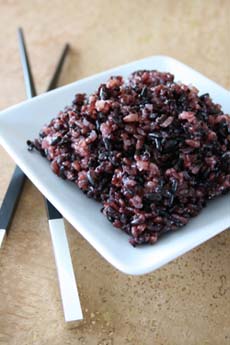
Black pearl rice, also called forbidden rice. Photo by Hannah Kaminsky | THE NIBBLE.
October 2007
Last Updated June 2026
|
 |
Rice: History & Types Of Rice
Page 2: Rice Glossary Terms A ~ B
This is Page 2 of a six-page article and glossary. Click on the black links below to visit other pages.
Glossary Of Rice Types
With 40,000 different types of rice, cultivated and wild, grown across the globe, we have attempted to provide an overview of the major types most Americans are likely to encounter. Please feel free to suggest additional terms.
Over the centuries, three main types of rice have developed in Asia, depending on the amylose content of the grain. They were called indica, long, slender grains high in amylose (a glucose polymer) that cook up into separate, fluffy grains of rice that in more primitive societies can be eaten with the fingers, and in more sophisticated ones work best as a bed for sauces or side dishes; japonica, shorter, plumper medium-grain rice that is low in amylose and cooks up sticky clumps to be eaten with chopsticks (and later, in paella, risotto and sushi); and javanica, with an intermediate amylose content and stickiness. Rice is further divided into long, medium, and short-grained varieties; different regions grow different varieties. Within each classification—long, medium, and short-grain—there are specialty rices, as you’ll see below.
This material is copyrighted and cannot be reproduced in whole or in part
without written permission. Write to Editors at TheNibble com.
AKITA KOMACHI RICE
One of the two japonica (medium-grain) rice varieties favored by the Japanese for sushi, along with koshihikari. Both types are not limited to cultivation in Japan, and are grown in California and elsewhere.
AMERICAN RICE
Thanks to technology that has eliminated the human labor factor in rice-growing, the U.S. is the world’s 12th largest exporter of rice. Arkansas, northern California, and Texas are leading growers, with mega-farms that use laser technology for scaling the fields and removing broken grains from the milled rice. As opposed to dozens of human laborers, fields are seeded by airplane, and harvested by a single combine operator, followed by a tractor alongside it that receives the harvested rice and delivers it to waiting trailers. Most domestic rice grown (60%) is consumed domestically as table rice, in restaurants, or into food products: made into beer, rice mixes, and pet food. Some is exported as well: California alone exports some 400,000 tons of rice to Japan, South Korea, and Taiwan in Asia; Turkey, Syria, and Jordan in the Middle East; and throughout the Pacific, South Americ,a and Europe.
ARBORIO RICE
|
This medium-length, round-grained rice is named after the town of Arborio, in Italy’s Po Valley, where it is grown. The grains have a more tan color with a characteristic white dot at the center of the grain. Primarily used in risotto, Arborio rice develops a creamy texture around a chewy center and has an exceptional ability to absorb flavors. The creaminess comes from a high starch content. Arborio is a japonica cultivar, the same variety that produces the other “sticky rices,” including mochi and sweet rice. See another photo of arborio rice in the group photo on the next page. See also carnaroli rice and vialone nano.
|
|
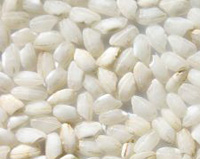
Arborio rice. Photo by Davide Guglielmo | SXC. |
AROMATIC RICE
Aromatic rices have a flavor and aroma similar to that of roasted nuts or popcorn. The better-known aromatic rices are the long-grain rices basmati and jasmine but any size grain can be an aromatic. The natural compound that provides the aroma and flavor is present in all rice, but is present in much higher concentrations in the aromatic varieties.
ASIAN RICE
This is an ambiguous term: Almost all of the rice we use today originated in Asia, although rice is now grown in most countries on earth. See specific listings for popular Asian varieties: basmati rice from India and Pakistan, jasmine rice from Thailand, kalijira rice from Bangladesh, etc. Also see japonica rice, which does not refer to Japanese rice but to all medium-grain rice.
BALDO RICE
|
A favorite rice in Turkish cuisine, baldo is a thick, short-grain rice that is used to make creamy risotto-type dishes, but it can be used in any recipe. The grains are stickier than other rice varieties that are used for risotto: arborio, carnaroli, and vialone nano. A member of the Japonica family of rices, the species was created by crossing the Arborio rice with the Stirpe 136 rice variety. It is classified as superfine rice. Baldo is a favorite of professional chefs because it cooks faster than these other varieties. Its plump, crystalline grains keep their shape at high cooking temperatures and are suitable for any kind of rice recipe.
Baldo is grown in Italy, Turkey, Vietnam, and elsewhere, including small amounts in the U.S.
|
|
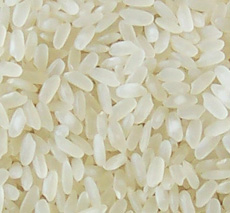
Baldo rice. Photo courtesy TradeIndia.com. |
BAMBOO RICE
Bamboo rice is a short-grain rice infused with fresh bamboo juice. It is moist and viscous when cooked, lending itself to sticky rice applications. (See photo on next page.)
BASMATI RICE
|
An aromatic, long-grain, slender, non-glutinous rice from India and Pakistan. When cooked, it swells only lengthwise, resulting in long, slender grains that are very dry, light, and separate—not sticky. Basmati has been cultivated for centuries at the foot of the Himalayan mountain ranges. The rice is long-grain and scented; literally translated from Hindi, it means ”queen of scents” or ”pearl of scents.” For centuries, it has been exported to the Arab countries, where many traditional rice dishes are cooked with basmati rice. See another photo of basmati rice on the next page.
|
|
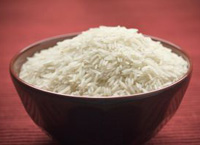
Basmati rice. Photo by Brandon W. Mosley | SXC. |
BHUTANESE RED RICE
A short-grain rice grown at 8,000 feet in the Himalayan Kingdom of Bhutan, and the chief rice in the Bhutanese diet. It is irrigated with a 1,000-year-old glacier rich in trace minerals, which provides a nutty/earthy flavor. It has a beautiful red russet color when harvested, which turns pinker when cooked; the cooked texture is soft. A long-grain red rice is also grown—see the photo in the chart on the next page.
|
|

Photo courtesy of Jugalbandi.Info. |
BLACK RICE or FORBIDDEN RICE
Black in color when raw, deep purple when cooked, black rice was once reserved for the ancient Chinese emperors, earning it the name “forbidden rice.” It has a deep, nutty taste—you can detect chocolate notes—and is high in fiber. It is rich in amino acids and high in vitamins and minerals such as iron, potassium, and magnesium. It pairs beautifully with all cuisines and can be enjoyed steamed plain, in a pilaf, stir-fried, or with salad. It makes a spectacular Thai rice pudding with coconut milk. Unlike other black rice from Asia, “forbidden rice” is not glutinous or rough. An organic variety is available from Lotus Foods and other purveyors. According to Lotus Foods, a specialist in exotic rices, Chinese scientific research indicates that black rice is beneficial to the kidneys, spleen, stomach, eyes, and blood circulation.
|
|
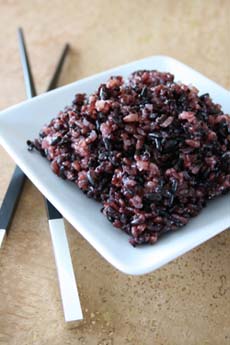
Black rice. Photo by Hannah Kaminsky | THE NIBBLE. |
BLACK JAPONICA® RICE
Black japonica rice is a spicy, aromatic rice that was developed in California from Japanese seeds by Lundberg Family Farms. It is actually a combination of two rices grown in the same field: an Asian black short-grain rice and a medium-grain, whole-grain mahogany (brown) rice (you can see a photo in the chart on the next page). When cooked, the rice provides a juicy texture, a nutty, mushroom-like flavor, and an exotic sweet spiciness. It pairs well with hearty meats and game, in stuffings, casserole,s and with stir-fried foods. See the photo of black japonica rice in the group photo on the next page.
BOMBA RICE
The finer of the two types of rice grown around the town of Calasparra in the Murcia region of Spain. It is the perfect rice for Paella. The basic difference between Bomba rice and others from Calasparra that were bred from it is that Bomba expands in width like an accordion rather than longitudinally, as do other rice strains. It is very labor-intensive and had almost died out, but was saved by the interest of the world’s best chefs. Bomba differs from Italian Arborio rice, which is bred to be creamy, and Asian rice, which is meant to be sticky. Like regular Calasparra rice, Bomba absorbs three times its volume in broth (rather than the normal two), yet the grains remain distinct.
|
|
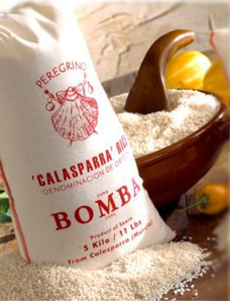
Bomba rice is available from LaTienda.com. |
BOTAN RICE
A brand of glutinous rice.
BROWN RICE or HULLED RICE
Brown rice is unpolished rice, milled to remove the hull from the kernel but retain the rice bran layer and the germ, which give it a nutty flavor and chewy texture. It also has a lower glycemic index and is more nutritious because the bran contains most of the vitamins, minerals, and fiber, rich in minerals and vitamins, especially the B-complex vitamin group. (In contrast, white rice is milled to remove the bran layer for a milder taste and texture, and brown and white rices have similar calories, carbohydrates, fat, and protein).
|
|

Brown basmati rice from India. Photo by Cris DeRaud | SXC. |
The light brown color/dark beige of brown rice is from the bran. Brown rice takes about twice as long to cook as white rice. Any rice—long-grain, short-grain rice, or sticky rice—may be harvested and milled as brown rice. Because of the Asian aesthetic for finely-polished white rice, brown rice was traditionally denigrated, associated with poverty and wartime shortages, and in the past was rarely eaten except by the sick, the elderly, and as a cure for constipation. Today, it is more expensive than common white rice, partly due to its low consumption and much shorter shelf life (because the oil in the germ will turn rancid). See also light brown rice.
Continue To Next Page, Rice Terms C ~ H
Go To Article Index Above

|











